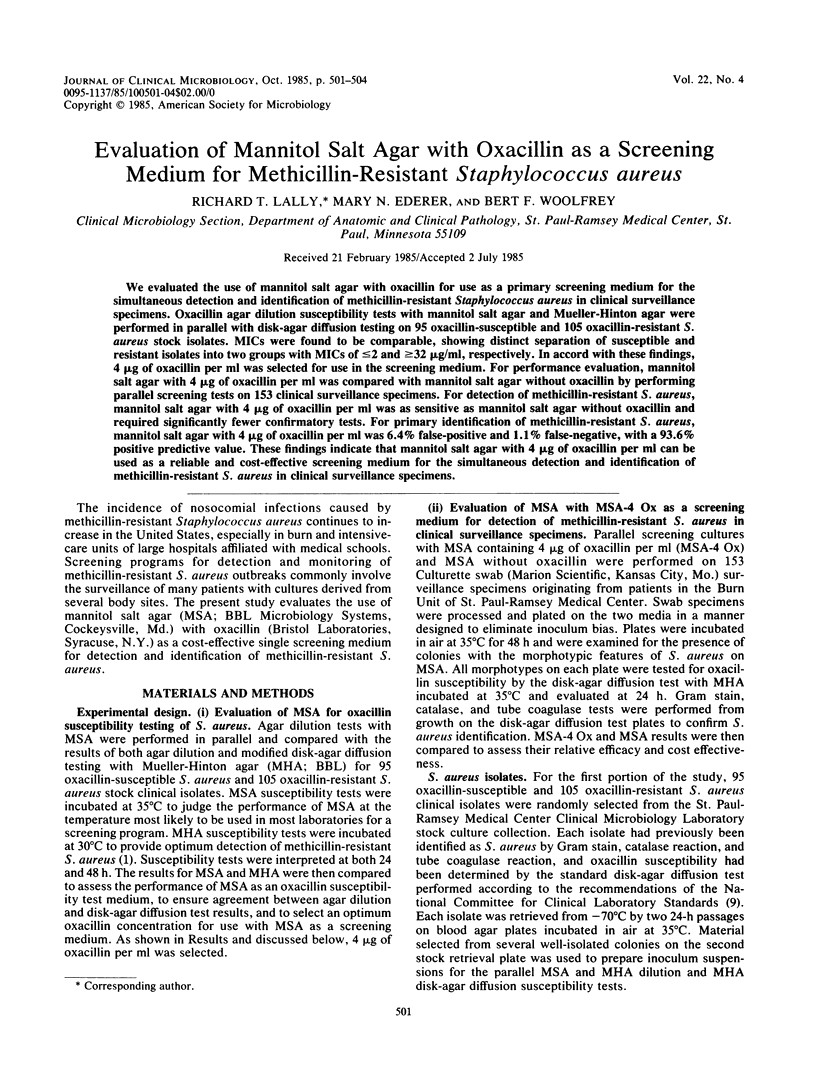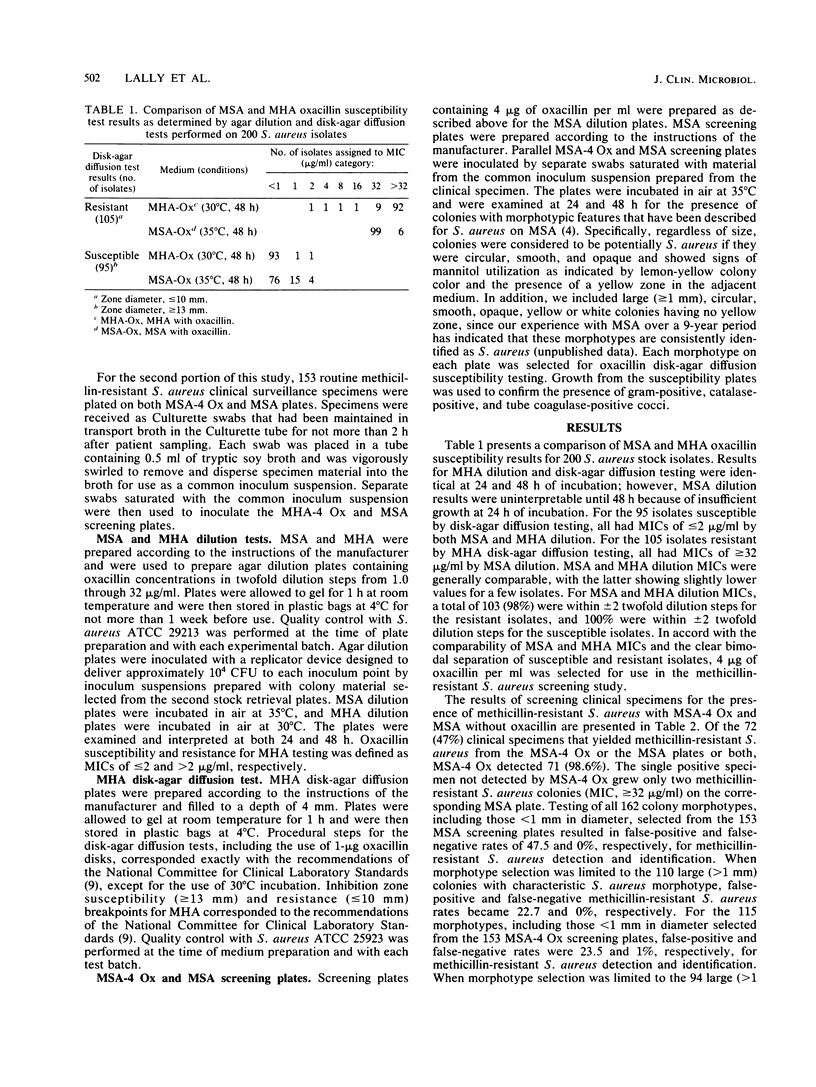Abstract
We evaluated the use of mannitol salt agar with oxacillin for use as a primary screening medium for the simultaneous detection and identification of methicillin-resistant Staphylococcus aureus in clinical surveillance specimens. Oxacillin agar dilution susceptibility tests with mannitol salt agar and Mueller-Hinton agar were performed in parallel with disk-agar diffusion testing on 95 oxacillin-susceptible and 105 oxacillin-resistant S. aureus stock isolates. MICs were found to be comparable, showing distinct separation of susceptible and resistant isolates into two groups with MICs of less than or equal to 2 and greater than or equal to 32 micrograms/ml, respectively. In accord with these findings, 4 micrograms of oxacillin per ml was selected for use in the screening medium. For performance evaluation, mannitol salt agar with 4 micrograms of oxacillin per ml was compared with mannitol salt agar without oxacillin by performing parallel screening tests on 153 clinical surveillance specimens. For detection of methicillin-resistant S. aureus, mannitol salt agar with 4 micrograms of oxacillin per ml was as sensitive as mannitol salt agar without oxacillin and required significantly fewer confirmatory tests. For primary identification of methicillin-resistant S. aureus, mannitol salt agar with 4 micrograms of oxacillin per ml was 6.4% false-positive and 1.1% false-negative, with a 93.6% positive predictive value. These findings indicate that mannitol salt agar with 4 micrograms of oxacillin per ml can be used as a reliable and cost-effective screening medium for the simultaneous detection and identification of methicillin-resistant S. aureus in clinical surveillance specimens.
Full text
PDF



Selected References
These references are in PubMed. This may not be the complete list of references from this article.
- Bartzokas C. A., Paton J. H., Gibson M. F., Graham F., McLoughlin G. A., Croton R. S. Control and eradication of methicillin-resistant Staphylococcus aureus on a surgical unit. N Engl J Med. 1984 Nov 29;311(22):1422–1425. doi: 10.1056/NEJM198411293112207. [DOI] [PubMed] [Google Scholar]
- Boyce J. M., White R. L., Causey W. A., Lockwood W. R. Burn units as a source of methicillin-resistant Staphylococcus aureus infections. JAMA. 1983 May 27;249(20):2803–2807. [PubMed] [Google Scholar]
- Chapman G. H. The Significance of Sodium Chloride in Studies of Staphylococci. J Bacteriol. 1945 Aug;50(2):201–203. [PMC free article] [PubMed] [Google Scholar]
- Gunn B. A., Dunkelberg W. E., Jr, Creitz J. R. Clinical evaluation of 2 -LSM medium for primary isolation and identification of staphylococci. Am J Clin Pathol. 1972 Feb;57(2):236–240. doi: 10.1093/ajcp/57.2.236. [DOI] [PubMed] [Google Scholar]
- JEFFRIES C. D. Comparison of six physiologic characteristics of staphylococci from laboratory specimens. Am J Clin Pathol. 1961 Aug;36:114–118. doi: 10.1093/ajcp/36.2.114. [DOI] [PubMed] [Google Scholar]
- KIMLER A. Evaluation of mediums for identification of Staphylococcus aureus. Am J Clin Pathol. 1962 Jun;37:593–596. doi: 10.1093/ajcp/37.6.593. [DOI] [PubMed] [Google Scholar]
- Locksley R. M., Cohen M. L., Quinn T. C., Tompkins L. S., Coyle M. B., Kirihara J. M., Counts G. W. Multiply antibiotic-resistant Staphylococcus aureus: introduction, transmission, and evolution of nosocomial infection. Ann Intern Med. 1982 Sep;97(3):317–324. doi: 10.7326/0003-4819-97-3-317. [DOI] [PubMed] [Google Scholar]
- Rutala W. A., Katz E. B., Sherertz R. J., Sarubbi F. A., Jr Environmental study of a methicillin-resistant Staphylococcus aureus epidemic in a burn unit. J Clin Microbiol. 1983 Sep;18(3):683–688. doi: 10.1128/jcm.18.3.683-688.1983. [DOI] [PMC free article] [PubMed] [Google Scholar]
- Saravolatz L. D., Pohlod D. J., Arking L. M. Community-acquired methicillin-resistant Staphylococcus aureus infections: a new source for nosocomial outbreaks. Ann Intern Med. 1982 Sep;97(3):325–329. doi: 10.7326/0003-4819-97-3-325. [DOI] [PubMed] [Google Scholar]


